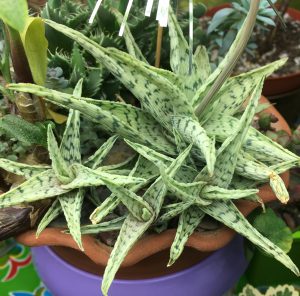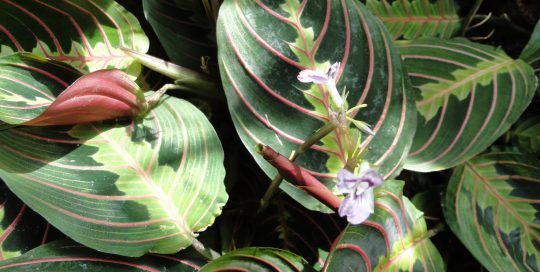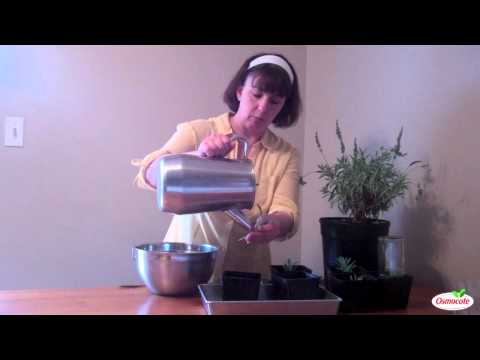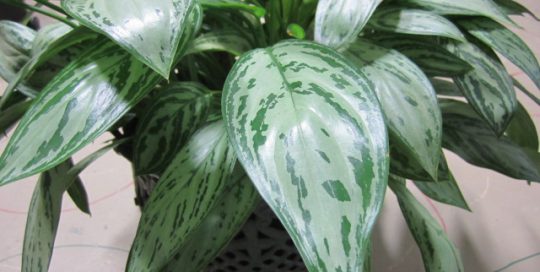While coaching my niece, an aspiring gardener, I compiled ten houseplant care tips for beginners that are just as useful for those with more experience. They cover houseplant basics, and go a long way toward keeping plant happy and healthy.
JJ, my niece, is just 14 years of age. She’s already nurtured at least a dozen customary varieties of houseplants. So far, it’s a family affair. Success with Pothos from her grandpa’s mature plant, was followed by a few Aloes from her Aunt Jean, and then on to a ZZ plant, and a couple of jade plants.

Aloe Plant (photo by Jean Starr)
She’s been raising baby plants from cuttings, and seeking out the best exposures throughout her house. In fact, she’s “borrowed” her parents’ south-facing bedroom window for the sun-lovers. And yes, she’s even experienced some plant deaths.
“You had nothing to do with it,” I told her when she texted me news of a recent plant’s demise.
Saying you killed a plant is taking way too much credit. I attempted to console her by telling her about a famous gardener who said, “If you don’t kill a plant at least three times, you’re not trying hard enough.”
She may never embrace my belief that a plant’s death is an opportunity, not a tragedy, but she’s starting to learn from the losses by endeavoring to find what went wrong.
There are some who may feel that any plant that enters the house has its own predetermined lifespan. It’s welcome as part of the home’s décor, and it’s admired until it’s no longer pretty. Others, however, feel they must do whatever they can to keep a plant alive. They either develop a knack for acting as an emergency plant responder, or they give up after a loss or two. JJ’s knack has grown into a fascination. She’s learned that nurturing plants is a constant learning experience, and that no matter how long she does it, it’s as much art as science.
With JJ’s help, here are the ten houseplant care tips –
- Keep your plants happy. While this might sound oversimplified, it involves learning about its favored lifestyle. Learn its name: if there is no tag in the pot, ask the seller to write down its name. Even if it’s just a common name, like “baby’s toes” or something like that, you can look it up online, finding a photo that matches your plant. I like to find at least two different sources to assure you’re getting the best advice. Cultural needs consider:
- Soil: does it need moisture-retentive, well-drained, or in the case of air plants (Tillandsias), no soil at all?
- Light: does it prefer direct sun, indirect light, diffuse light? The beauty of growing plants in pots is that you can move them to the best spot.
- Water: it’s best not to leave moisture to chance. Buy a moisture meter and learn how to use it.
- Pot size: no plant likes to live in too large a pot. In fact, it many prefer to be pot-bound. Gradually upgrade into containers that contain about twice as much soil as it’s currently growing in.
- Keep plant’s living space clean: As my mother used to say, “Don’t just clean around it; clean under it.” It will go a long way toward keeping your plant healthy.
- Keep plants clean: most indoor plants benefit from added humidity. While spritzing your plants with water doesn’t provide lasting air moisture, it helps keep your plants clean. Spritz plants at least once a day, avoiding those with fuzzy leaves like African violets, or succulents.
- Using plastic pots allows you to better assess your plant’s water needs. Terra cotta is nice, but a simple plastic pot with drainage will allow you to eventually determine by its weight whether it is wet or dry. It won’t preclude the help of a moisture meter, which is a must for indoor gardeners.
- Allow the plant to soak up as much water as it needs with the proper saucer. This is one of the most important houseplant care tips in this list. I use cachepots to prettify the plastic pots. Mostly ceramic, they allow me to water without fear of drips on the furniture. Still, make sure you don’t leave the plant sitting with its feet wet for more than a few minutes, which is plenty of time for its roots to soak up what it needs.
- If a plant isn’t directly beneath a light source, keep it from growing cock-eyed by giving it the plant a quarter clockwise turn each day. Clockwise or counter-clockwise, choose one and stick with it for consistency’s sake.
- Remove dead and damaged leaves; they just attract insects and disease. There is absolutely no need for a plant to hold on to its dead leaves. Most of them drop when dead, but those that remain should be clipped off and thrown in the trash. Keep the soil clean by removing dead leaves from the soil surface.
- It’s best to catch problems early, so look at your plants daily. Obvious signs of trouble include a change in its leaves, and insects on the plant. Take the plant into a well-lit spot and use a magnifier if you have one to do a close inspection of its stems and leaves.
- When a plant begins to look bad, perform a version of plant triage:
- Check for moisture. You kill more houseplants than overwatering. It’s hard to go wrong with a moisture meter.
- Look for insects with your lighted magnifier or at least in bright light.
- Carefully remove dead leaves. Just because they’re dead doesn’t mean you should tear them away. Give the plant a gentle shake first. If the leaf doesn’t come easily away from the plant, use clippers.
- Look for signs of new growth – it’s a great visual pat on the back, and means your plant is happy.
- Check stems emerging from soil, making sure they aren’t soft and black. New growth is a good thing, unless it reaches a certain size before wilting or dropping.
- And finally, don’t be afraid to pitch a plant with insects and/or diseases that you haven’t found a way to remedy. This is especially relevant for people who have more than one plant in the vicinity. Bugs, both visible and microscopic, know how to get around.
Try an item from this list of ten houseplant care tips, and see how your houseplants respond. The more you care for your plants, the more invested you’ll become. When JJ came home from vacation and found her cats had knocked her jade plant over and broke off some of its branches, she decided to try on my ‘glass half-full’ outlook. “I’m trying to look at it as an opportunity to make some baby jade trees,” she told me in a text. “I used rooting hormone and potted them up last night.”
JJ’s Favorites:
- Pothos: one of the best for beginners, easy to propagate
- ZZ plant: shiny and bright, no matter where it is in the house.
- Jade plant: easy to grow if you don’t overwater
- Aloe: flexible in its needs; will flower when ‘happy’
Jean’s Favorites:
- Butterwort: nearly impossible to overwater, this carnivorous plant even catches gnats
- Pilea: a huge family, there’s one for every situation
- Citrus: flowers are fragrant, blossoms easily in bright light or in a south-facing window
- Pelargonium (annual geranium): consistent winter bloomer in bright light








